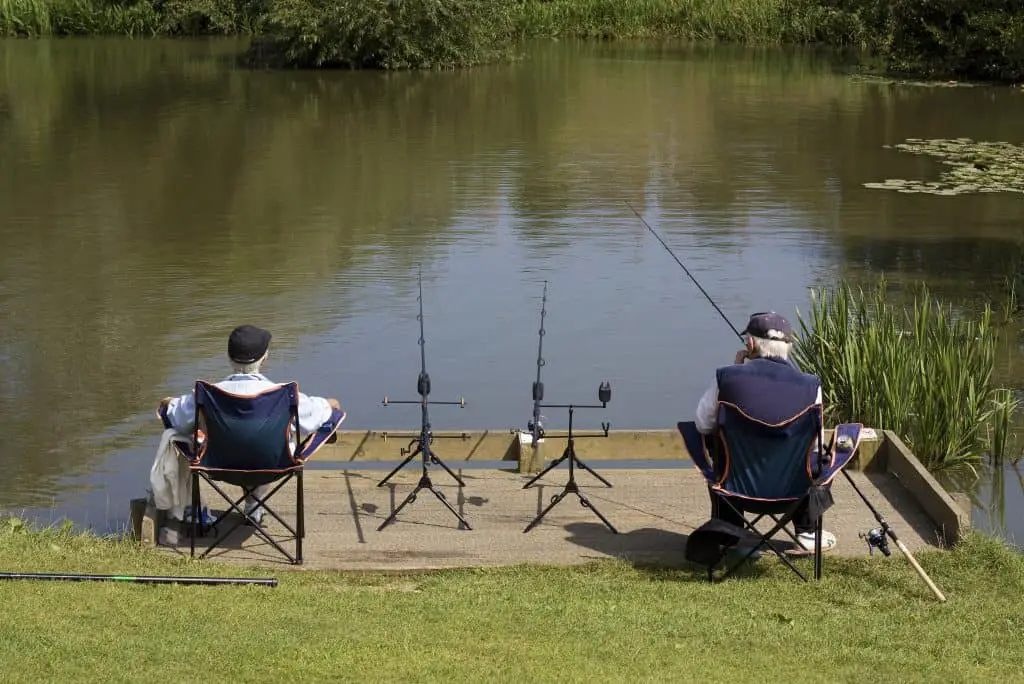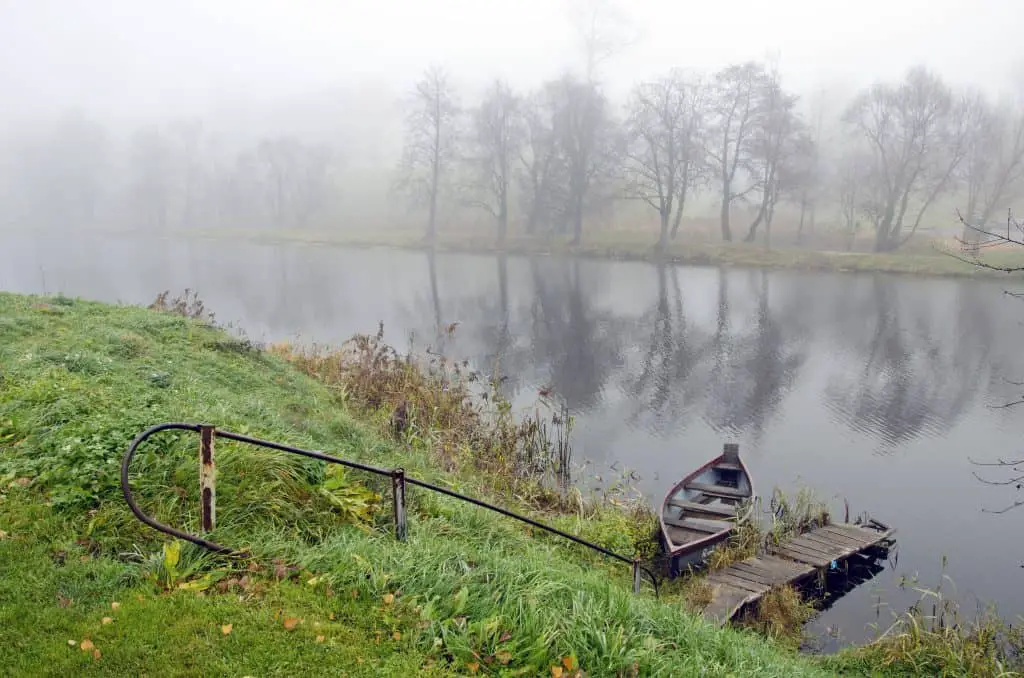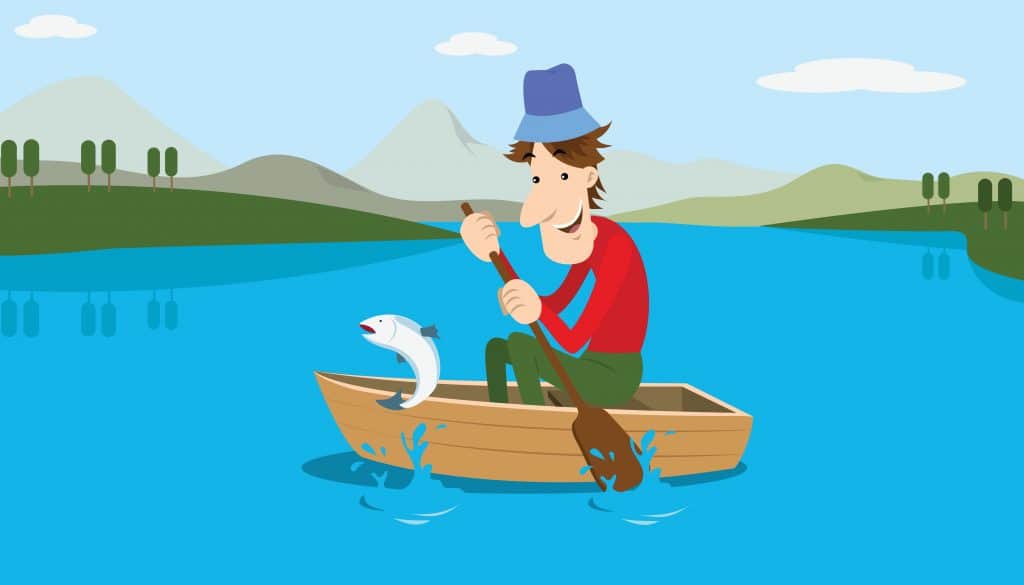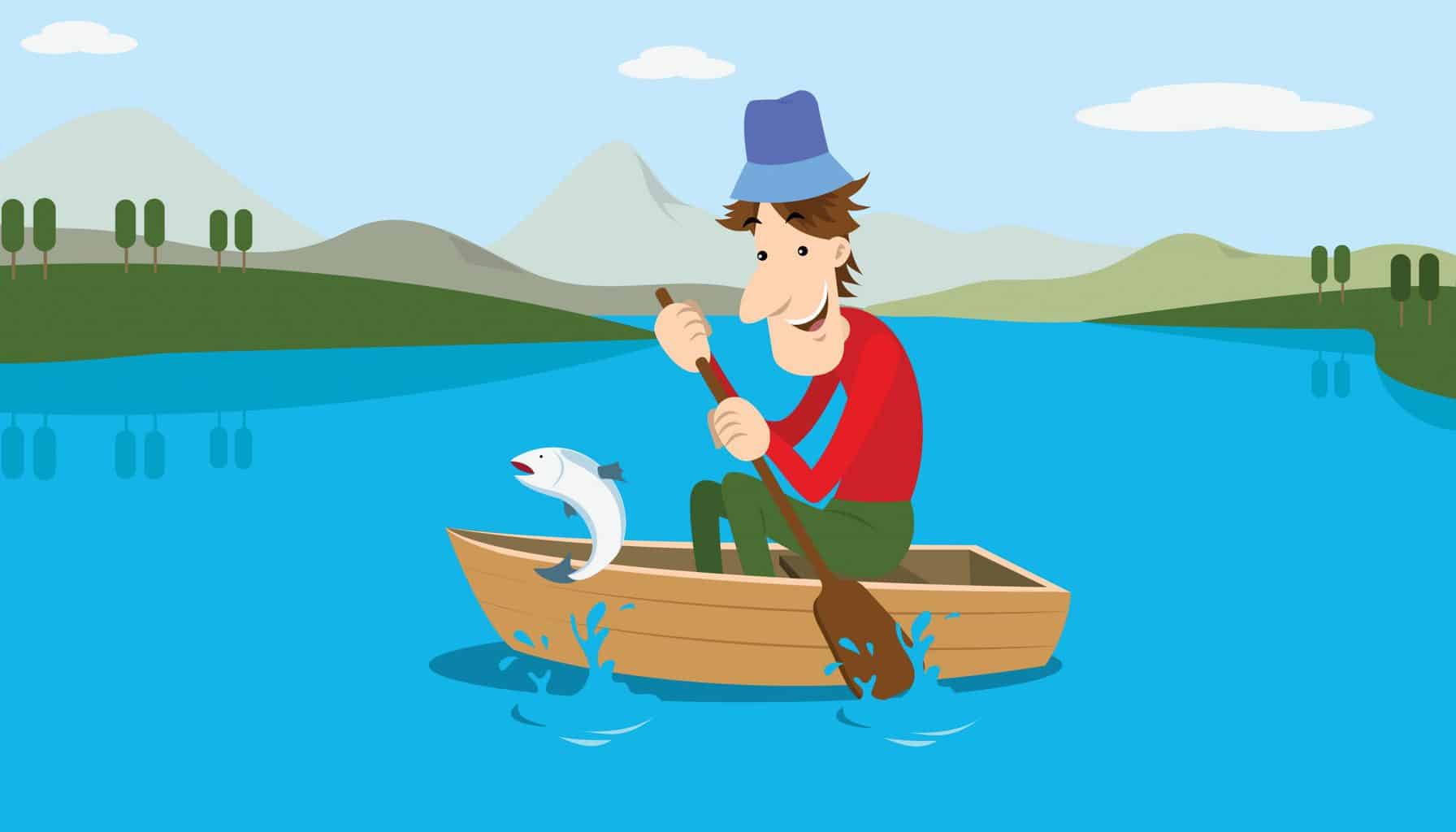You can spot fishermen and women really at any time on the waters. They could be out to hunt for the day’s catch or testing their flies and combos for the coming season. On some water bodies, there are fishing time restrictions. Others restrict fishing past 10 pm or 12 pm. You can spend the whole day or night fishing but knowing the best time to go fishing will go a long way in increasing your yield!
Most fishermen will agree that the best time to catch fish is at dusk and dawn. Fish love to bite when the temperatures are slightly lower. That being said, the best time to go fishing depends on a variety of factors. Among them are weather, tides, natural events, and the fish species.
The location also influences the best time to fish. There is so much you need to know beyond the best equipment. Let’s have a look at what to watch out for in general and more specifically by time of day and season. For more info on a particular fish species, check out the links towards the end of the article!
What is the Best Time to Catch Fish?
Fish possess a lateral line system. Depending on how the pressure shifts, these lateral lines help them to detect such changes. Rising pressure is considered better by the fish and they will feed well at this time. The opposite is true, when the pressure falls.
The moon is another determinant of the feeding habit of fish. Usually, the moon moves in phases, and the phase in which it currently is will determine how active fish will be. They could be biting more or less. Fish are more active during the new moon phase than they are during the waning crescent.
Warm and sunny times force fish to migrate to cooler waters. They might go deeper and be calm there. When it is cloudy, you have greater chances of higher yields because sunlight is covered by clouds. Water temperatures too control fish behavior like their body temperature, when to feed, how much to feed, and other functions. The morning sun will warm the shallow waters making the water temperatures for fish to eat. Late mornings are considered the best time to catch.
Tides too dictate the best fishing times. When the tides are rising and falling, your chances of landing good deals are higher. Water movements make your baits move too. These make coastal fish more active. If you are a freshwater fisherman, the best time is when fish are spawning. Fish will bite more during these days as most take annual vacations.
Summer comes with a change in the diet as bigger fish stop feeding on the elusive half or one-year-old fish and opts for newborns that are easy to catch. They will always be full during these times and have plenty to feed on so they won’t go after spinners, spoons, and plugs, and much as they used to. Your luck will improve in the fall as small fish that survived the summer are undergoing a growth spurt. These will make it harder for big fish to hunt them. Fishing should be better during the winter season. However, as the temperatures drop further, their digestion slows. For instance, a fish will take over 345 hours to digest a minnow it would in a few hours if it was summer.
There is a relationship between the best time to catch fish and the amounts of sunlight, fish depth, warming trends, weather patterns and storms, wind, and tidal flows when targeting saltwater areas. All fish are considered ectothermic or cold-blooded. They can maintain their body temperatures at constant levels. The temperatures of the surrounding will influence the body temperatures of these buddies and their body functions too. The temperatures dictate when they will eat and how much they will feed on.
When water temperatures are low, the body movements of fish reduce so does the food intake. A fisherman/woman should understand such biological changes and adjust their baits and lures slower retrieves in cold water and faster retrieves in warmer water.
Some conditions are related. For example, most freshwater fish like bass are most active in the early mornings and late evenings. Fish don’t love more light. They find reduced light more comfortable. Fewer winds and turbulence on water in the ponds and lakes during the mornings and evenings allow them to cruise in shallow waters looking for food or move to the sub-surface.
Best Time of the Day to go Fishing
It can be a daunting task to decide on the most preferred time of the day to load your fishing tackle and step out. Novices and amateurs still experience this. Some have spent hours without getting any bite as fish might not be feeding actively at the time when they are out. You should go at the times when the chances of landing a friend are higher.
There are so many factors that will influence the behaviors of the fish you are targeting. You should know that there are no fast and hard rules that surround the best fishing times of the day. We will address the times of the day and help you understand the times to strike and catch the day’s limit.

Morning
The early morning has the lowest temperatures just before it dawns. This can be one of the best times to hit the waters. Especially in late spring, the summer, and early fall season when the day temperatures are higher. Usually, you wouldn’t meet crowds at this time so you don’t have to deal with loud kids and splashing waters.
There are very low light levels in the early mornings. This will be the best time if you be targeting fish with proper sight when the light conditions are low like catfish and bass. Early summer mornings are loved by flying insects which make for excellent forage for catching bluegill, trout, and other species that love to eat from the surface.
Fishing in the early mornings in winter isn’t a great time target as the air and water temperatures are at the extreme lowest of the entire 24-hour phase. At this time, most fish are inactive as they wait for the sun to warm the waters slightly.
The few hours between the late mornings and early afternoons mostly present very challenging fishing when the warmer months set in. Most fish species prefer to swim deeper where the waters are colder. The sun is blazing hot at this time. This encourages bass and other species to go dormant as the fisherman’s vision is at its best at this time. It makes it almost difficult to fish at this time unless you use fish finders.
During the daytime, rain, wind, and overcast conditions could help improve the chances of hooking a fish. Clouds, rain, and wind reduce the light levels penetrating the water surface. Temperatures too will slightly drop.
If you are fishing in colder areas during the late mornings and early afternoons, this can be the best time for success. In fact, the ONLY time that can yield ad the sun warms the cold water allowing fish to move better and hunt more.
Afternoon
Here, we major on the late afternoons, and just like the early mornings, it will be productive to fish at this time especially in the summer, fall, and spring. The sun takes a lower position and water starts cooling off. Fish are encouraged to be active and look for food. There is dimmer light at this time and predators such as bass are stimulated to eat.
Have in mind that morning patterns will take a reverse direction in the late afternoon. Light and temperature levels will drop as you cast. Shadows too won’t be the same. If there is shade in the eastern bank of the lake in the morning, there will be shade in the lake’s western banks. Winter will have the fishing action calming down rapidly in the late afternoons.
Night
In warmer weather, the time between sunset and midnight will be more productive. Some factors to consider will be the intense darkness, techniques, and tackle. However, some game fish species like walleye, catfish, and bass will feed aggressively at this time. For the best topwater fishing action, the nights with moonlight are to target. The fish can easily see your lure when they are at the bottom. Or you could consider using artificial light to attract fish, which is allowed in some states.
As the night advances and dawn approaches, fishing will slow down. Temperatures will drop farther but a fisherman/woman can occasionally catch some fish. You shouldn’t stop trying. Cold weather makes night fishing less productive. Very few species feed as much in the winter and even lesser will feed in the heart of the nights.
Best Time to Go Fishing by Season
By now, you should know that fish are mostly influenced by weather patterns. If you are looking for the best time to go fishing by season, you need to make sure that the fish you are targeting are there and that they are in a feeding or biting mood. Being ectothermic, they are extremely sensitive to changes in temperature.
For you to understand the best fishing time by seasons, you need to know how temperatures change from spring to winter.
Spring
Once the ice melts, the water surface on lakes will begin to warm up. The spring turnover cycle of water from the surface to the bottom in lakes and pond occur. Warm water goes to the bottom of the lake from the surface. Coldwater moves to the top from the bottom. Fish refrain from the deep sections and remain in the shallow waters where the water will warm up easily. Here is also where the first growth of water plants in spring happens.
The early mornings of spring have fish in dire need of food and spawning. Winter will be over by then. Water temperatures are still low and won’t heat up quickly because of the lower sun and bouncing rays off the water. This is a bad time to fish as the water temperatures are higher.
Late mornings and early afternoons of spring welcome more sunrays that penetrate through the water and it warms. Wind will push warm water with planktons and food. Fishing the downwind shorelines will be the best bet.
In the late afternoon and early evening, the sun heats the water and most fish will feed a lot. Their metabolism and digestive systems will have been cranked up.
Summer
In the summer the water surface of lakes and ponds is properly heated. This keeps a warm layer well-defined over the cooler ones. Fish love cooler waters but need more oxygen levels present in warm water. They will be forced to move to a section between the two water levels-the cold and the warm layer.
The section they frequent could be 2 to 10 feet deep but this will depend on the pond or lake’s size. Most fishers prefer identifying a section or structures that extend outwards from the body’s shoreline. It should gradually slope into the thermocline. Fish find warm water here but will have quicker access to the cooler, deeper, and safe water.
From early mornings to the late afternoons of spring, fishing yields more. It should be before sunrise to hours before the mid-morning. Summer has a lot of cover and food for fish. It will be very difficult to find hungry fish. From the late mornings to the early afternoons the water is warm. Fish will migrate deeper where there is colder water. They move to cool off the excess heat. For the better part of this period, fishing is extremely poor.
Autumn
As autumn sets in, the air temperatures are cooler. Water on the surface and sub-surface of the lake is cooler. Its density is as heavy as the waters that are the coldest at the bottom. Strong winds will move the water on the surface around allowing it to mix with deeper waters. This is called the autumn turnover. Mixing will continue until the temperature of the water on the lake is very uniform. The oxygen levels too will be more uniform. This triggers the fish to be more active and move freely. If these conditions continue, finding fish will be very difficult. The situation prolongs until when the weather is cold and chills the surface of the lake.
In the early mornings of autumn, the sun is very low and can’t penetrate the water surface as it is cold. From sunrise to the early morning, there is very little to almost no biting. Late mornings to noon still have cold waters because of the season. You can enjoy pure fishing in the warm shallow waters.
The late afternoons to early evenings have the sun directly overhead. This lasts some hours and warms the water on the surface and sub-surface. Fishing will yield as these chaps are gaining more weight in readiness for winter. There will be so many fish bait schools and larger fish will be there.
Winter
Water temperatures are among the crucial elements of locating and hooking fish. Being ectothermic, the colder seasons have the fish’s metabolic rate slowing down to the lowest point. They will feed less. On cold days, they spend time in warmer waters available. To hook some more identify deeper dredge canals, holes, and pockets near the shallow flats. Your presentation should be slowed down to a crawl. In colder waters, the retrieve will be slower.
Warmer waters in winter pose the highest chances of landing fish. Target deeper waters in the early mornings. Sunny winter days should send you to the flats for a good time as the temperatures here are rising steadily.
Currents that trigger fish to feed could come from the winds and tides. Fish love to hold in the wind side or the down tide of a section with the currents sweeping across. There are bouts of colder weather with some sunny days. Head to the flats in the late afternoons on these days. The water will have absorbed as much radiation. Fish will have moved to these areas to feed. Sections with dark bottoms can be the best targets in the late afternoons.
Coldwater is very clear so using lighter tackle will be a great idea because they will not be as visible. They won’t spook fish. Fish are highly responsive to the dynamics of atmospheric pressure. Cold fronts welcome higher pressure that completely shuts down fishing. Finally, of course there is ice fishing, which is a whole other ballgame. Obviously, winter is not a bad season for this 😉

Other Factors Influencing the Best Time to Catch Fish
Fishing at the perfect time is very critical for successful fishing trips. You can be at the best fishing location and with the right tackle. However, you might not hook anything if you head there at the wrong time. Other factors will influence the best time to go fishing. We have mentioned them above but this section has each explained in detail.
Climate and Temperature
Water temperatures on inland ponds and lakes settle in the horizontal layers of the cold water and warm water separated by the thermocline. The thermocline is a moderate layer and the most-preferred feeding section.
On oceans and large lakes, some fish will be cruising in the warm top layer. Sometimes, they will be in the bottom cold section of the topmost layer or varied depth still within the thermocline. Different fish species have different water temperatures they prefer to live and feed in. targeting these areas increases your chances of hooking more fish.
Fish being ectothermic, they will be very dormant in cold water. They will be sluggish and won’t feed as much. When the water is extremely warm, they run to comfortable sections. For species that love cold water, you will spot most of them on the surface in autumn and deeper in spring. Those that love warmer waters will cruise the surface in summer and go deeper in autumn.
Fish vary as each species has a temperature range they find more comfortable to live in. Cold or hot water temperatures lock out oxygen from the water. This makes fish dormant so fishing quickly slows down when temperatures are extremely high or low.
Winds and Rain
Light rains and showers wash insects into water. This means there is more food for fish to feed on. Fishermen/women who fish from the shores or boats, light rains make you invisible. The worst time to fish is when the rains are heavy as the water flow changes in rivers. This makes fish uncomfortable to maintain their position. They find it difficult to spot lures and bait.
Wind influences fishing success. When it is windy, the gusts carry baitfish and food. Trophies ad game fish will come after baitfish. If fishing offshores during these times especially from a boat, head to the protected shorelines and cast with the gusts.
Storms will affect your fishing yields. Fish hunt more before the storm. They can’t do it during and after a storm. In the colder season, most fish are in search of food after warmer fronts move in. Fish are more active near warmer surfaces. Colder fronts decrease water temperatures hence poor fishing.
Amount of Light
In hot zones, fish feed mostly in the early mornings and evenings. They move deeper in the afternoon. Deeper fishing bites will be the best bets at midday. When it is sunny and warm, fish head to cooler and deeper waters as it is more comfortable there. You will get high yields on cloudy days as cloud overage diffuses light.
In the morning, the sun will warm shallow water and create more comfortable temperatures. Fish become more active. It will be great to fish in the late mornings. The late afternoons and early mornings have minimal light and cooler temperatures. Fish will spend the most time in the shallow sections to feed.
Tides when Saltwater Fishing
Falling and rising tides are perfect when the waters aren’t so deep or so low. As the water levels drop, the fish sense is and move out of these areas with the tides to a deep section. When the levels increase, larger fish like redfish, drum, trout, and flounder go with the rising tide. Tides move with baits and this triggers active feeding among coastal fish.
Tides will lower and raise water levels about twice a day. This affects the positioning of the fish and their feeding. Timings of higher or lower tides change daily and differ with locations.
Moon Phases
Moon Phases impact fish’s feeding habits. As the sun and moon move, they directly affect the level of the sea. Fishing in the full moon, last quarter, first quarter, and the new moon is the best time to catch fish. You can increase your hunts if you plan trips in the full moon when the tides are low in the night. The waves of water that are between the sea and estuaries make fish come from deeper points to the surface.
The Body of Water your are Fishing in
This falls under the location you intend to visit. First, research the location and see what other fishermen/women have caught and at what times. Check with the local fishing stores and bait shops to enquire about the area and the yielding times. Comb local fishing blogs, magazines, YouTube-channels and podcasts too.
Species
The type of fish species is undoubtedly one the biggest differentiating factors regarding the best time to go fishing. We will not go into too much detail here though. Instead, we have written detailed articles for you for a range of different species, which you can find below. Missing any? Let us know!

Best Time to Go Fishing – Conclusion
All said and done, don’t shy from asking other local anglers their best times to fish. Local regulars have a lot of information that can help you target your times right. As much as you consider how the times of the day, weather, and other factors affect fishing yields, don’t forget to think about how they can affect you.
Even before the fun, it is important to be safe and comfortable. If you didn’t know, comfortable anglers catch the most fish. And there is so much fun as they engage their tackle. Think about how miserable fishers feel. Take the necessary precautions to stay safe and comfy depending on the time of the day you step out to fish as we have explained above. Just as there is bad fishing gear, there are wrong fishing times!
